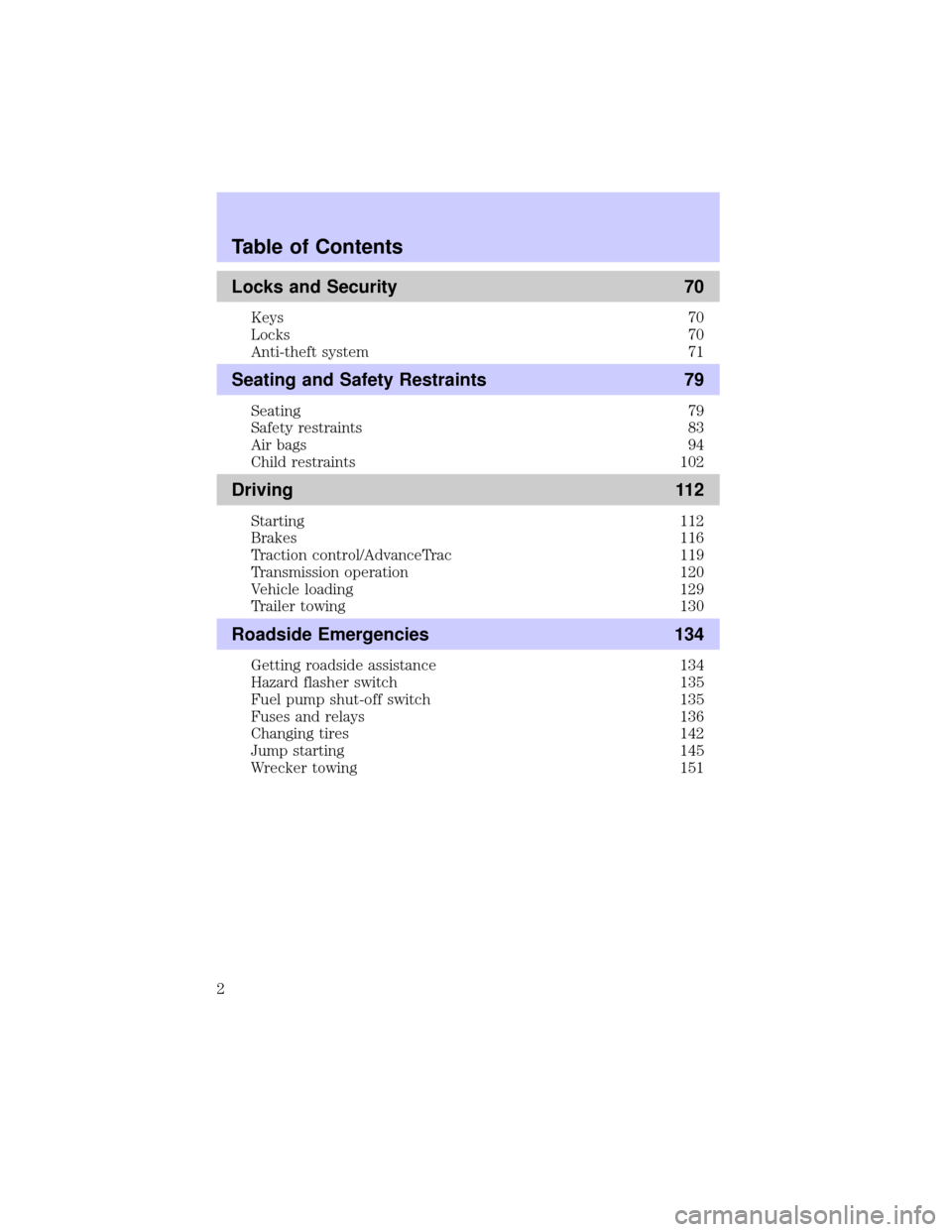jump start Mercury Mercury Cougar 2002 Owner's Manual
[x] Cancel search | Manufacturer: MERCURY, Model Year: 2002, Model line: Mercury Cougar, Model: Mercury Mercury Cougar 2002Pages: 216, PDF Size: 4.04 MB
Page 2 of 216

Locks and Security 70
Keys 70
Locks 70
Anti-theft system 71
Seating and Safety Restraints 79
Seating 79
Safety restraints 83
Air bags 94
Child restraints 102
Driving 112
Starting 112
Brakes 116
Traction control/AdvanceTrac 119
Transmission operation 120
Vehicle loading 129
Trailer towing 130
Roadside Emergencies 134
Getting roadside assistance 134
Hazard flasher switch 135
Fuel pump shut-off switch 135
Fuses and relays 136
Changing tires 142
Jump starting 145
Wrecker towing 151
Table of Contents
2
Page 134 of 216

GETTING ROADSIDE ASSISTANCE
To fully assist you should you have a vehicle concern, Ford Motor Company
offers a complimentary roadside assistance program. This program is
separate from the New Vehicle Limited Warranty. The service is available:
²24±hours, seven days a week
²
for the New Vehicle Limited Warranty period of three years or 60,000
km (36,000 miles), whichever occurs first on Ford and Mercury vehicles,
and four years or 80,000 km (50,000 miles) on Lincoln vehicles.
Roadside assistance will cover:
²changing a flat tire.
²jump-starts.
²lock-out assistance.
²limited fuel delivery.
²towing of your disabled vehicle to the nearest Ford Motor Company
dealership, or your selling dealer if within 56.3 km (35 miles) of the
nearest Ford Motor Company dealership (one tow per disablement).
Even non-warranty related tows, like accidents or getting stuck in the
mud or snow, are covered (some exclusions apply, such as impound
towing or repossession).
Canadian customers refer to your Owner Information Guide for
information on:
²Coverage period
²Exact fuel amounts
²Towing of your disabled vehicle
²Emergency travel expense reimbursement
²Travel planning benefits
USING ROADSIDE ASSISTANCE
Complete the roadside assistance identification card and place it in your
wallet for quick reference. In the United States, this card is found in the
Owner Guide portfolio in the glove compartment in Ford vehicles and is
mailed to you if you own a Mercury or Lincoln. In Canada, the card is
found in the Owner Information Guide in the glove compartment.
U.S. Ford or Mercury vehicle customers who require roadside assistance,
call 1±800±241±3673; Lincoln vehicle customers call 1±800±521±4140.
Canadian customers who require roadside assistance, call
1±800±665±2006.
Roadside Emergencies
134
Page 145 of 216

4. Insert the tapered end of the jack
handle beneath the hub cover (if
equipped) and push in. Twist off to
remove the cover. Loosen each
wheel lug nut one-half turn
counterclockwise but do not remove
them until the wheel is raised off
the ground.
5. Place the jack under vehicle in
location indicated by arrows (closest
to the tire requiring changing), then
jack up the vehicle until the tire is
clear of the ground.
6. Remove the lug nuts with the lug wrench.
7. Replace the flat tire with the spare tire, making sure the valve stem is
facing outward. Reinstall the lug nuts until the wheel is snug against the
hub. Do not fully tighten the lug nuts until the wheel has been lowered.
8. Lower the wheel by turning the jack handle counterclockwise.
9. Remove the jack and fully tighten the lug nuts in the order shown.
10. Put flat tire, jack and lug wrench away. Make sure the jack is
fastened so it does not rattle when you drive. Unblock the wheels.
JUMP STARTING YOUR VEHICLE
The gases around the battery can explode if exposed to flames,
sparks, or lit cigarettes. An explosion could result in injury or
vehicle damage.
Batteries contain sulfuric acid which can burn skin, eyes and
clothing, if contacted.
Do not attempt to push-start your vehicle. Automatic
transmissions do not have push-start capability; also, the
catalytic converter may become damaged.
Roadside Emergencies
145
Page 146 of 216

Preparing your vehicle
When the battery is disconnected or a new battery is installed, the
transmission must relearn its shift strategy. As a result, the transmission
may have firm and/or soft shifts. This operation is considered normal and
will not affect function or durability of the transmission. Over time, the
adaptive learning process will fully update transmission operation.
1.Use only a 12±volt supply to start your vehicle.
2. Do not disconnect the battery of the disabled vehicle as this could
damage the vehicle's electrical system.
3. Park the booster vehicle close to the hood of the disabled vehicle
making sure the two vehiclesdo nottouch. Set the parking brake on
both vehicles and stay clear of the engine cooling fan and other moving
parts.
4. Check all battery terminals and remove any excessive corrosion before
you attach the battery cables. Ensure that vent caps are tight and level.
5. Turn the heater fan on in both vehicles to protect any electrical
surges. Turn all other accessories off.
Connecting the jumper cables
1. Connect the positive (+) booster cable to the positive (+) terminal of
the discharged battery.
Note:In the illustrations,lightning boltsare used to designate the
assisting (boosting) battery.
+–+–
Roadside Emergencies
146
Page 148 of 216

4. Make the final connection of the negative (-) cable to an exposed
metal part of the stalled vehicle's engine, away from the battery and the
carburetor/fuel injection system.Do notuse fuel lines, engine rocker
covers or the intake manifold asgroundingpoints.
Do not connect the end of the second cable to the negative (-)
terminal of the battery to be jumped. A spark may cause an
explosion of the gases that surround the battery.
5. Ensure that the cables are clear of fan blades, belts, moving parts of
both engines, or any fuel delivery system parts.
Jump starting
1. Start the engine of the booster vehicle and run the engine at
moderately increased speed.
2. Start the engine of the disabled vehicle.
3. Once the disabled vehicle has been started, run both engines for an
additional three minutes before disconnecting the jumper cables.
+–+–
Roadside Emergencies
148
Page 150 of 216

3. Remove the jumper cable from the positive (+) terminal of the booster
vehicle's battery.
4. Remove the jumper cable from the positive (+) terminal of the
disabled vehicle's battery.
After the disabled vehicle has been started and the jumper cables
removed, allow it to idle for several minutes so the engine computer can
relearnits idle conditions.
+–+–
+–+–
Roadside Emergencies
150
Page 208 of 216

Cleaning your vehicle
engine compartment ..............162
instrument panel ....................164
interior .............................164±165
plastic parts ............................163
washing ....................................161
waxing .....................................161
wheels ......................................162
wiper blades ............................164
Climate control (see Air
conditioning or Heating) ............44
Clock ..........................26, 33, 41, 60
Clutch
fluid ..........................................192
operation while driving ..........125
recommended shift speeds ....126
Console ........................................67
Coolant
checking and adding ..............177
low coolant light .......................12
refill capacities ................181, 199
specifications ..................200±201
Cruise control
(see Speed control) ....................61
Customer Assistance ................134
Ford accessories for your
vehicle .....................................166
Ford Extended Service
Plan ..........................................154
Getting assistance outside the
U.S. and Canada .....................158
Getting roadside assistance ...134
Getting the service you
need .........................................152
Ordering additional owner's
literature .................................159
The Dispute Settlement
Board .......................................154Utilizing the
Mediation/Arbitration
Program ...................................157
D
Daytime running lamps
(see Lamps) ................................47
Defrost
rear window ..............................46
Dipstick
automatic transmission
fluid ..........................................192
engine oil .................................172
Doors
door ajar warning .....................15
lubricant specifications ..........200
Driving under special
conditions
through water .........................128
E
Emergencies, roadside
jump-starting ..........................145
Emission control system ..........189
Engine ........................................201
check engine/service engine
soon light ..................................10
cleaning ...................................162
coolant .....................................177
idle speed control ...................175
lubrication
specifications ..................200±201
refill capacities ........................199
service points ..................170±171
starting after a collision .........135
Engine block heater .................115
Engine oil ..................................172
checking and adding ..............172
Index
208
Page 210 of 216

Inspection/maintenance (I/M)
testing ........................................190
Instrument panel
cleaning ...................................164
cluster ........................................10
lighting up panel and
interior .......................................48
J
Jack ............................................142
positioning ...............................142
storage .....................................142
Jump-starting your vehicle ......145
K
Keys .......................................74±76
key in ignition chime ...............16
positions of the ignition .........112
L
Lamps
bulb replacement
specifications chart ..................51
cargo lamps ...............................48
daytime running light ...............47
fog lamps ...................................47
headlamps .................................47
headlamps, flash to pass ..........48
instrument panel, dimming .....48
interior lamps ...........................50
replacing bulbs .........................51
Lane change indicator
(see Turn signal) ........................50
Lights, warning and indicator ....10
air bag ........................................12
anti-lock brakes (ABS) ....11, 117
brake ..........................................11
charging system ........................12check coolant ............................12
check engine .............................10
cruise indicator .........................13
door ajar ....................................15
high beam .................................14
low fuel ......................................13
low washer fluid .......................15
oil pressure ...............................12
overdrive off ..............................13
safety belt .................................12
speed control ............................65
traction control active ..............13
turn signal indicator .................13
Load limits .................................129
GAWR ......................................129
GVWR ......................................129
trailer towing ..........................129
Locks
doors ..........................................70
Lubricant specifications ...200±201
M
Manual transaxle
fluid capacities ........................199
lubricant specifications ..........201
reverse .....................................127
Manual transmission .................125
Message center ...........................66
Mirrors
side view mirrors (power) .......60
Moon roof ....................................65
Motorcraft parts ........................198
O
Octane rating ............................185
Odometer .....................................17
Oil (see Engine oil) ..................172
Index
210
Page 211 of 216

P
Panic alarm feature, remote
entry system ................................73
Parking brake ............................118
Parts (see Motorcraft parts) ....198
Power distribution box
(see Fuses) ...............................139
Power door locks ........................70
Power mirrors .............................60
Power steering ..........................120
fluid, checking and adding ....190
fluid, refill capacity ................199
fluid, specifications .........200±201
Power Windows ...........................60
R
Radio ......................................26, 34
Radio reception .....................42±43
Rear window defroster ...............46
Relays ........................................136
Remote entry system ...........71, 73
locking/unlocking doors .....70, 72
opening the trunk .....................73
panic alarm ...............................73
replacement/additional
transmitters ...............................74
replacing the batteries .............73
Roadside assistance ..................134
S
Safety belts (see Safety
restraints) ..................15, 83, 85±88
Safety defects, reporting ..........160
Safety restraints ..............83, 85±88belt minder ...............................89
cleaning the safety belts ..........93
extension assembly ..................93
for adults .............................85±87
for children .....................102±103
warning light and
chime .............................12, 15, 88
Safety seats for children ..........106
Seat belts (see Safety
restraints) ....................................83
Seats ............................................79
child safety seats ....................106
cleaning ...................................164
SecuriLock passive anti-theft
system ....................................74±76
Servicing your vehicle ..............167
Spare tire (see Changing the
Tire) ...........................................142
Spark plugs,
specifications .....................198, 201
Specification chart,
lubricants ...........................200±201
Speed control ..............................61
Speedometer ...............................17
Starting your
vehicle ........................112±113, 115
jump starting ..........................145
Steering wheel
controls ................................59, 61
tilting .........................................59
T
Tachometer .................................18
Tires ...........................142, 195±196
changing ..........................142±143
checking the pressure ............196
replacing ..................................197
Index
211